The Bangladesh Delta Plan (BDP) 2100 is a long-term, integrated, and holistic vision of water and land management throughout Bangladesh. It aims to support the country’s long-term development in the face of the opportunities and risks that emerge from the interface between water, climate change, and human activity4. Bangladesh has made great strides in development under the Sixth Five Year Plan (FY2010–FY2015), and aspires to build on this momentum to reach upper middle-income country status and eliminate extreme poverty
Found 159 Results From

Ending Extreme Poverty in Bangladesh During the Seventh Five Year Plan: Trends, Drivers and Policies Background Paper for the Preparation of the Seventh Five Year Plan
 February 22, 2021
February 22, 2021 The present paper examines this positive poverty reduction experience and points to the need for undertaking further action to ending extreme poverty forever. Accordingly, the paper is structured in nine sections.

Linking Equity and Growth in Bangladesh Background paper prepared for The Seventh Five Year Plan
 February 22, 2021
February 22, 2021 The concern with equity has emerged strongly in recent global debates on economic progress. This has happened partly in recognition of the fact that in spite of great strides made by the world in recent times in promoting growth of incomes and ensuring higher standards of living across the globe (the setback caused by the recent financial crisis notwithstanding), inequality between and within nations has not diminished.

Nutrition Background Paper to inform the preparation of the 7th Five Year Plan
 February 22, 2021
February 22, 2021 This paper was prepared with significant contributions from Dr. AM Zakir Hussain, Professor MQK Talukder *, Dr. Tahmeed Ahmed in close consultations with representatives of the Institute of Public Health Nutrition, the Ministry of Health and Family Welfare, the Food Planning and Monitoring Unit of the Ministry of Food, development partner representatives including the Canadian Department of Foreign Affairs, Trade and Development (DFTD), the Delegation of the European Union (EU), the United Kingdom Department of International Development (DFID), the United States Agency for International Development (USAID), the World Bank, and the United Nations Renewed Efforts Against Child Hunger and Undernutrition (UN REACH) agencies FAO, Unicef, WFP and WHO.”
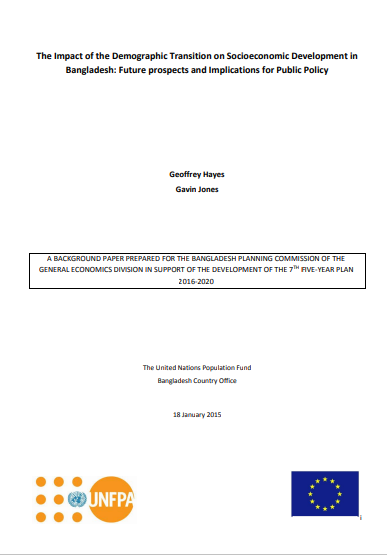
BACKGROUND PAPER PREPARED FOR THE BANGLADESH PLANNING COMMISSION OF THE GENERAL ECONOMICS DIVISION IN SUPPORT OF THE DEVELOPMENT OF THE 7TH FIVE-YEAR PLAN 2016-2020
 February 22, 2021
February 22, 2021 This paper is a highly condensed summary of an earlier more elaborate draft titled “The Impact of Demographic Trends on Socioeconomic Development in Bangladesh: Future Prospects and Implications for Public Policy,” prepared for the UNFPA Bangladesh Country Office and the Genera Economics Division of the Planning Commission of the Government of Bangladesh.

Background Paper on Health Strategy for preparation of 7th Five Year Plan
 February 22, 2021
February 22, 2021 To see Bangladeshi people healthier, happier and economically productive to make the country a middle income country by 2021, despite many challenges to overcome, based on impressive gains achieved in health outcomes in past together with further consolidation of past efforts, new and innovative strategies need to pursue; doing more of the same may not be effective, rather exploration of new ways of doing business is the demand.
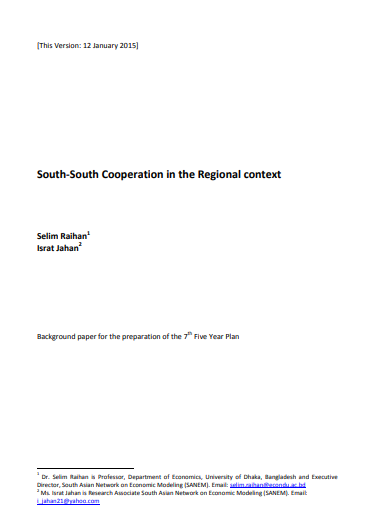
Background paper for the preparation of the 7th Five Year Plan South-South Cooperation in the Regional context
 February 22, 2021
February 22, 2021 South-South cooperation is initiated, organized and managed by developing countries themselves; often, Governments play a lead role, with active participation from public- and private-sector institutions, non-governmental organizations and individuals. It involves different and evolving forms, including sharing of knowledge and experience, training, technology transfer, financial and monetary cooperation and in-kind contributions.
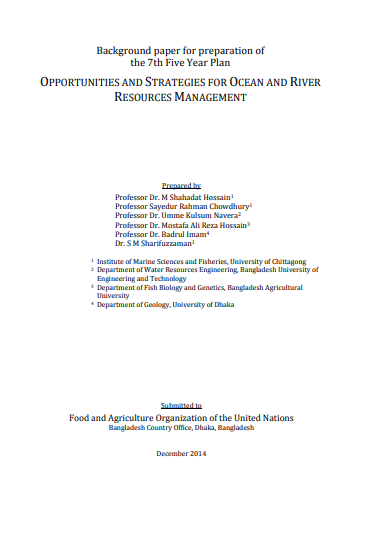
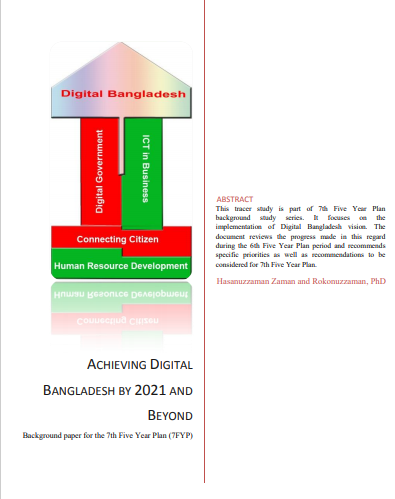
ACHIEVING DIGITAL BANGLADESH BY 2021 AND BEYOND Background paper for the 7th Five Year Plan (7FYP)
 February 22, 2021
February 22, 2021 This tracer study is part of 7th Five Year Plan background study series. It focuses on the implementation of Digital Bangladesh vision. The document reviews the progress made in this regard during the 6th Five Year Plan period and recommends specific priorities as well as recommendations to be considered for 7th Five Year Plan.

Agriculture Sector Development Strategy: background paper for preparation of 7th Five Year Plan
 February 22, 2021
February 22, 2021 The purpose of this paper is to (i) make an objective assessment of the nature of performance of the agriculture sector during the 6th Plan period, (ii) identify the factors contributing to the nature of performance, (iii) identify the opportunities and challenges for the future, especially for the 7th Plan period and (iv) propose policies and strategies to address the challenges and opportunities.
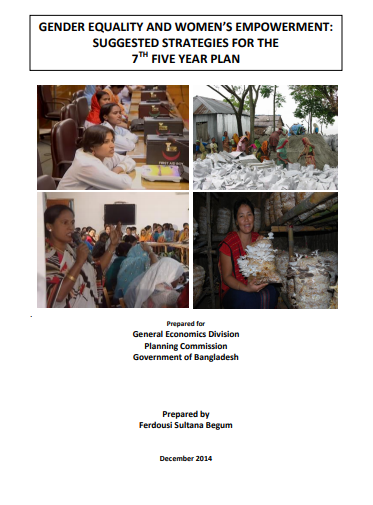
GENDER EQUALITY AND WOMEN’S EMPOWERMENT: SUGGESTED STRATEGIES FOR THE 7TH FIVE YEAR PLAN
 February 22, 2021
February 22, 2021 The present paper reviews progress on gender equality under the SFYP, recommends priority issues to be addressed, and suggests strategies for consideration while preparing the 7FYP. Section 2 of the report sets the situation of Bangladesh within the current global and Asia-Pacific regional context. Section 3 reviews the progress of the SFYP in line with the strategy for gender equality and women’s empowerment and Section 4 provides an analysis of the challenges and limitation of achieving the targets of the SFYP.
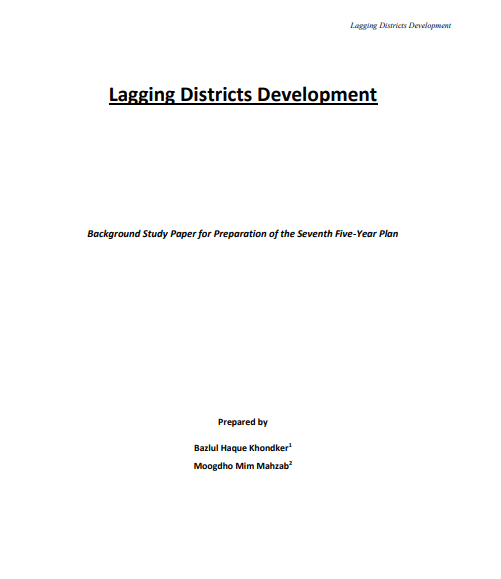
Lagging Districts Development – Background Study Paper for Preparation of the Seventh Five-Year Plan
 February 22, 2021
February 22, 2021 Most of the papers concentrating on the regional disparity of Bangladesh have analyzed the hypothesis of inequality from the perspective of greater districts. Either they took East and West as two broad districts or the comparison has been made among the seven divisions of Bangladesh. This approach actually misses the relative micro picture of the economy which is essential to address the lagging districts more precisely. It has been seen in recent data that some districts in the west have done better than to that of some districts in the east. For that reason this paper will analyze the whole issue from the district level development.
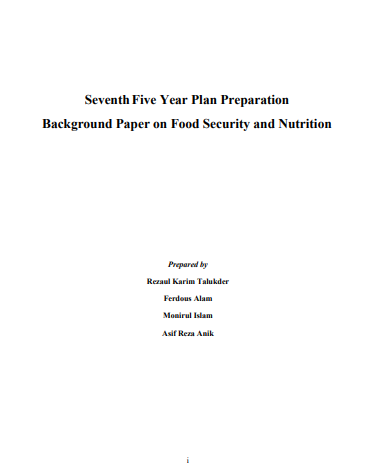
Seventh Five Year Plan Preparation – Background Paper on Food Security and Nutrition
 February 22, 2021
February 22, 2021 The purpose of this paper is to review progress of the detailed dimensions of food security under the 6th Five Year Plan and set the food security goal, objectives, targets and implementation strategy under the new 7th Five Year Plan (FYP). Attempt is also made to make an outline of the new National Food Policy, to be aligned with the 7th FYP, in line with the terms of reference for preparing the paper.
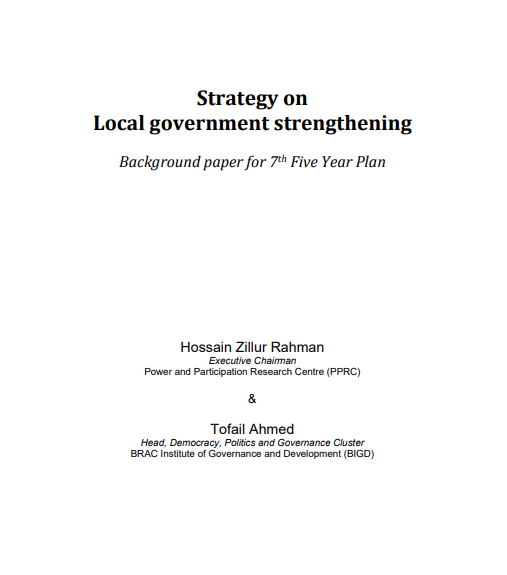
Strategy on Local government strengthening – Background paper for 7th Five Year Plan
 February 22, 2021
February 22, 2021 The 7th Five Year Plan offers a unique opportunity to build a fresh approach to the decentralization and local governance agenda for Bangladesh. At one level, there will have to be a large and obvious element of continuity of priorities from earlier planning documents. At another level, however, there is an opportunity for re-thinking that lies in factoring in the new realities and challenges and thereby engage all relevant stakeholders in a compelling process of re-thinking on why and how decentralization and local governance is critical to ensuring Bangladesh’s ambitions of inclusive prosperity
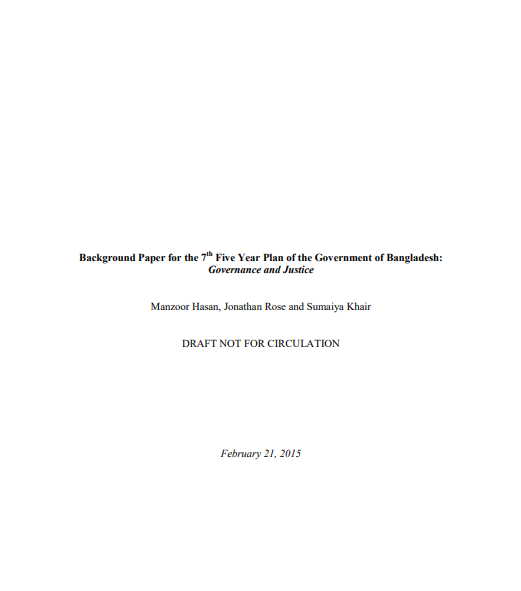
Background Paper for the 7th Five Year Plan of the Government of Bangladesh: Governance and Justice
 February 22, 2021
February 22, 2021 The purpose of this paper is to provide guidance to the 7th Five Year Plan (FYP) on governance, including justice. Governance has become as a major public priority in Bangladesh. Strengthening the institutional framework for sustainable development at all levels has emerged as one of the crucial areas to be addressed in the 7th FYP.
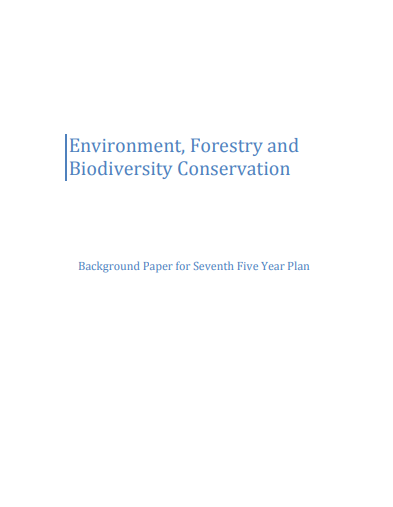
Background Paper for Seventh Five Year Plan – Environment, Forestry & Biodiversity Conservation
 February 22, 2021
February 22, 2021 The objective of the study is to explore environmental sustainability activities, review past policies, strategies & plans, asses Bangladesh’s stance with regard to MEAs, review the priorities outlined in the 6FYP, analyze progress towards the targeted benchmarks, review achievement/ failures of national sustainable development strategies, governance issues etc with a view to ensure inclusive and equitable economic growth and environment, forestry and biodiversity conservation.
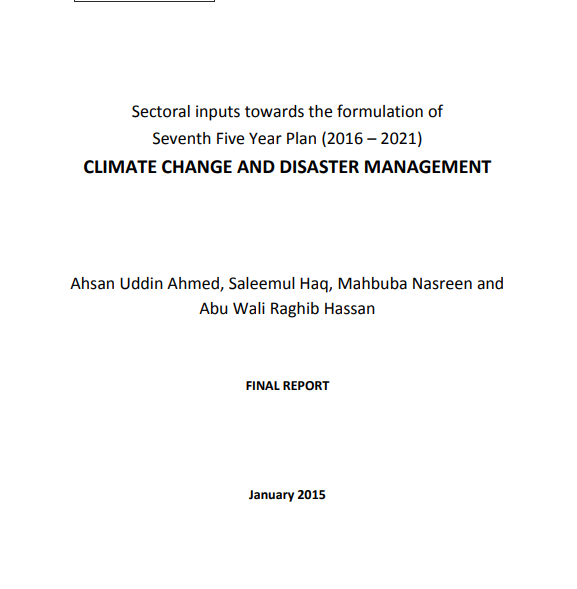
Seventh Year Plan – Climate Change and Disaster Management
 February 22, 2021
February 22, 2021 The Government of Bangladesh has initiated the process of formulating its Seventh Five Year Plan for the period 2016-2020. A total of 28 background papers, mostly sector-specific, have been identified – each of which will be completed as inputs towards formulating the Plan. The GOB recognizes that the country is highly prone to a variety of hazards and her disaster risk reduction needs are amongst the highest in the world. Moreover, the country and its poor people are most likely to be severely affected by global climate change, which in turn will exacerbate hazard related adverse impacts. As per GOB decision, a paper on climate change and disaster risk reduction is perceived to provide insight into the GOB’s current state of preparation, delivery of services, gaps between needs and services being provided, and future directions to avoid major adverse implications of both climate change and disaster risk reduction.
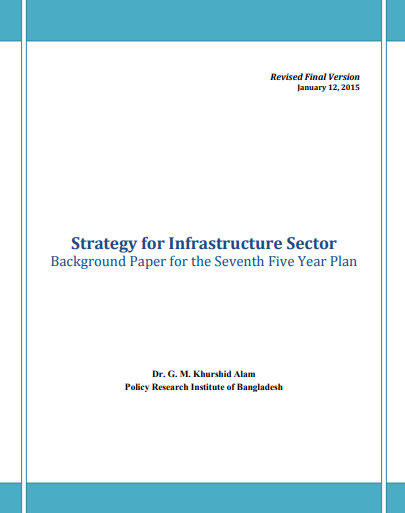
Background paper for Seventh Year Plan – Strategy for Infrastructure Sector
 February 22, 2021
February 22, 2021 The World Economic Forum regularly updates countries position on competitiveness based on 12 pillars. Infrastructure (transport and energy infrastructure) is a key pillar for economies like Bangladesh. Comparison of infrastructure among developing Asian countries shows that despite progress Bangladesh is still substantially deficient in terms of the quality of infrastructure in regards to all the countries shown in Table 1 except Myanmar. The gap in infrastructure quality is especially large when compared with Thailand, China, India and Sri Lanka. So Bangladesh needs to bring more focus to the efficient implementation of infrastructure investments along with necessary institutional changes relating to implementation, regulation, and policy formulation.

Seventh Year Plan – Financial Market Developments & Challenges-in-Bangladesh
 February 22, 2021
February 22, 2021 The financial sector is a vital part of an economy because of the role it plays in intermediating savings of the private and public sector to productive activities including investment. Bangladesh financial system is dominated by the banking sector, which fundamentally depends on short- and medium-term deposits for financing their lending portfolios. This limits availability of funds that would be required for long-term investments like infrastructure and housing. Bangladesh has a capital market, with its known difficulties, and there is no vibrant secondary market for bonds, which limits the availability of resources for infrastructure financing. This paper starts with a general overview of the current structure of the financial system in Bangladesh in terms of the 4 key markets—money market comprising banks, microfinance institutions and nonbank financial institutions, stock market, bond market and insurance market--and their sizes, relationships between the various markets and the associated regulatory bodies assigned to govern the different market segments.
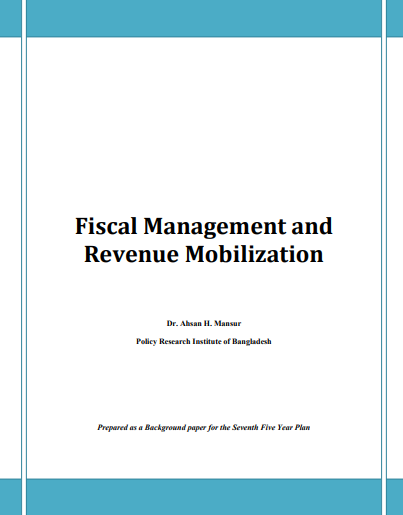
Seventh Year Plan – Fiscal Management and Revenue Mobilization
 February 22, 2021
February 22, 2021 Bangladesh despite being a least developed economy has had a relatively strong track record of prudent fiscal management and has made some progress in revenue mobilization efforts in the last decade. Good fiscal management in terms of keeping the fiscal deficit and public debt at sustainable levels, despite limited public sector resource mobilization, has served as the anchor to Bangladesh’s continued macroeconomic stability. The good fiscal management notwithstanding, public sector service delivery in terms of coverage and quality were seriously constrained by the limited success in resource mobilization.


